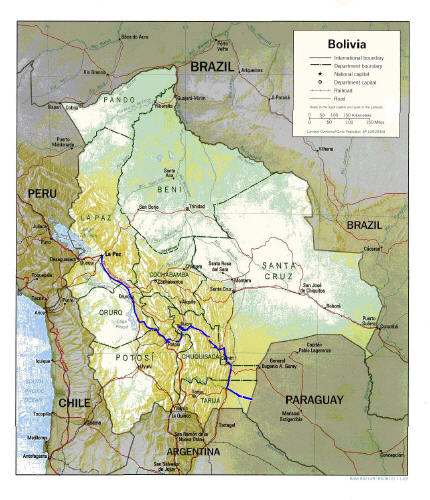 Sunday 21 to Monday 22 November 2010, to
Sucre
Sunday 21 to Monday 22 November 2010, to
Sucre
 Sunday 21 to Monday 22 November 2010, to
Sucre
Sunday 21 to Monday 22 November 2010, to
Sucre
The road from the border immediately turned into dirt and followed the tar road which is...... you guessed it..............under construction! Welcome to Bolivia.
About 60k from the border we came to immigration, identified by a hand painted sign. The first thing he wanted to see was the exit stamp from Paraguay. But we hadn't seen the immigration post nor any sign indicating immigration. It is about 40k before the border apparently! Since we had already left the country and had insufficient diesel to return, besides the problem with the car, he stamped us into Bolivia. Now we are also persona non-grata in Paraguay. OOPs
Time was passing so we camped off the road in the dry dusty Chaco. Next day we asked a few times to ensure we were on the correct road to Villa Montes. There are roads going every where and we wanted to be sure we were on the right one. We were, its a case of following your nose. One house I tried to ask at was empty but with the door open. The mud-brick dwelling consisted of one room with two beds, a few blankets, some cooking equipment and locked cupboards on a dirt floor. Definitely subsistence farmers.
This time we actually found the town centre of Villa Montes and a bank - no ATM but we could change some US Dollars and buy some diesel at an inflated foreigner price. They also wanted to charge the inflated price in Camiri on the main road to Santa Cruz. Pieter bargained and we got 30 litres at the normal price plus tip. Soon after we turned off to Sucre and onto a dirt road which is being improved in places. The scenery is lovely. Just the type we really enjoy. Mountains, hills, panoramas and trees. The flatter places in the valleys are cultivated but most of the land cannot be farmed. We went up and down over mountain ranges eventually starting to climb in earnest. Sucre is at 2,800m. The 600k journey from Villa Montes cannot be accomplished in one day, the roads do not allow this. We spent the night in a hotel, just as well as it was raining the next morning. The town had diesel with no questions about the price we should pay. Finally we came to a concrete road, lovely. It lasted a few kilometers and we were diverted onto a detour road. This road was never meant to be the main road. It was narrow, passing required care, and it went through small rivers and very bad patches. We were tired by the time we arrived but found a parking garage and hotel easily.
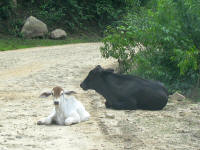
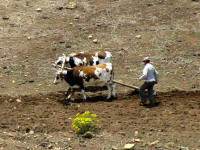
Tuesday 23 to Friday 26 November 2010, Sucre (elevation 2,807m)
Sucre is a lovely town with white buildings and a vibrant market. We had breakfast in the market. The first day was coffee, stale bread and jam. Second was better, a corn drink and Api which seems to be the Brazilian acei plus fried bread. The last 2 mornings I had fruit salad, that was magnificent.
The Museo de Arte Indigena was very
interesting. It is part of a project to encourage weaving by indigenous
communities. They provide education where necessary, assistance with sales and
other help. Originally only women wove. The men saw the success of the project
and now they also weave. The designs differ and the men are reviving the ancient
method of double ring weaving which is used to make fringes. The entire process includes the spiritual with
offerings to the local Virgin to ensure the weaving goes well and to provide
inspiration. The designs are based on the weavers interpretation of the world
around them. They change over time as the people change.
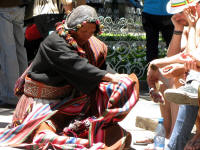
The main square is a great place to watch people.
Including a demonstration against violence against women. The parade was followed by a mimed play. There were 3 couples. Each enacted the man about to beat the woman freezing at this point to allow the other couples to enact a similar scene. A happy girl comes along sees the violence, says its wrong and decides to change things. She does this by rearranging the poses and putting a smile on the actors faces, then snapping them awake. An excellent performance.
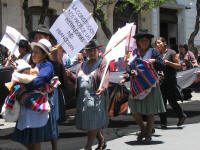
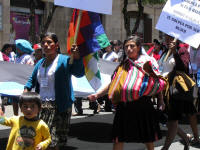
Saturday 27 to Sunday 28 November 2010, Potosi (elevation 3978m)
The first impression of Potosi is one of zinc roofs shining in the sun and un-plastered buildings. The streets in the old section are narrow and do not conform to either of the 2 maps I had. Finding a hotel was made more difficult because of road works and the many streets shut off for the parade. The parade marked the 200th anniversary of Potosi. Eventually we parked and walked to see the parade which went down the street that the hotel was in. It was fantastic. Groups of dancers and musicians were all beautifully dressed. The parade was rather sporadic. A few groups would pass then there was up to half an hour break before the next group came. Groups often had to stop and wait for the ones ahead to move on. It was lovely to watch.
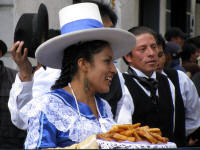
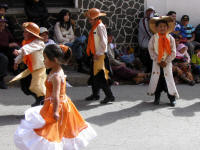
The reason to come to Potosi is to see the silver mines. These have been going for 465 years and only 30% of the minerals have been extracted. They were started by the Spanish and underwrote the Spanish economy for a century. The quality of silver was excellent then. Now the quality is not as good and it is mixed with zinc and lead. All 3 metals are mined. The rocks are sold to an smelter where the metals are separated from the rock. The mine is paid according to the quality and quantity of the minerals extracted. The miners work two 3 hour shift with a 2 hour break between shifts. They chew coca leaves to give them energy to do the work. They pray to the god Gobierno for rich ore and safety. Coca leaves, cigarettes and 96% proof alcohol are given to the Gobierno as gifts. Gobierno is definitely male. There is another god Tio included in the Shrine. Women do not work in the mine as it is considered bad luck. They work outside. There are some 10,000 workers in the mines spread over 26 co-operatives and the government mine.
The tunnels are supported by Eucalyptus poles. The ladders are also made of Eucalyptus. There are no safety measures in place. We had to scramble over blasted rocks in some places. The air is full of dust with barely adequate ventilation. Miners suffer from Silicosis and stop working when 80% of their lungs are affected. Blasting is done at 12:00 and 5:00pm. This is to allow the dust to settle before work is resumed. Winches, both hand and electric are used to bring the rocks up from the mine to the level with rail tracks.
First we put on protective clothing, pants, gum boots, jacket, hard hat with light. Then we purchased gifts for the miners and Gobierno. These consisted of coca leaves and soft drinks for the miners, coca leaves, 96% proof alcohol and cigarettes for Gobierno, dynamite, silicone and a fuse to make a big bang for us. Then it was into the mine. I found it very interesting but physically demanding. We climbed down 3 sets of ladders, about 60 meters each. There was a break between each set while an aspect of mining was explained. Not so going up! That was one long haul. Hard when your not very fit and it is over 4000m above sea level. It took a few days for the pain in my thighs to go away.
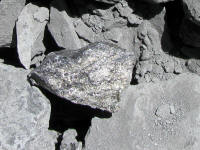
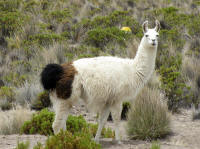
Monday 29 November 2010, Oruro (elevation 3726m)
Up and down through the mountains until we eventually started driving across a large plateau past herds of Llamas. Oruro is really a stop over for us. There are hot springs nearby and various museums to visit. Instead we rested. We both have a loss of energy due to the height and need rest.
Tuesday 30 November to Friday 3 December 2010, La Paz (elevation 3634m)
Our first view of La Paz was stunning. La Paz is built along a valley and has spread right up the sides. Once again there are plenty of unfinished buildings. Apparently taxes are only paid on finished buildings.
The city is vibrant with cake shops, street sellers, and museums. Sitting and watching the passing crowd is great, especially the women in bowler hats. The Witches Market is very touristy. There are llama fetuses and various charms for sale along with the usual tourist souvenirs.
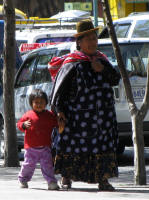
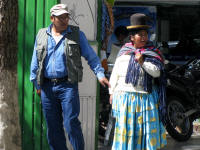
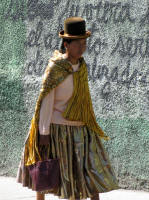
I enjoyed the Coca Museum. It covers the coca tradition among the Andes peoples and modern day production of cocaine. Various points are made. This is my selection. Coca from 3,000 years ago has been found, so it has been chewed and used in religious ceremonies for a long time. In 1551 the church condemned coca because of its spiritual associations. In 1573 they changed their minds and said it was essential to the life of the Indians. Why? Because the Indians were forced to work in the mines for 48 hour days without adequate sleeping breaks (eating underground is considered wrong by the Indians) and chewing coca allowed them to be productive over this period. They were paid in coca leaves. These days it would be considered slavery. The conquistadors took control of coca production. Commerce wins out! In 1905 a chemist named Einhorn synthesized procaino, one of the active ingredients in coca. The reason for isolating and synthesizing the active ingredient was because of coca's value as an anesthetic. Modern medicine uses this almost exclusively today. Natural coca was driven off the market and later banned. Some time after this cocaine was produced and sold into Europe and the USA. In 1976 Harvard University published a study and compared coca to quinoa, peanuts and wheat due to its nutritional value. Now the benefits of coca are reaped by pharmaceutical companies and illegal cocaine producers. The Indians do not make large amounts of money from coca. Several countries in Europe and of course the USA are allowed to produce a limited amount of coca per year. One of the pharmaceutical companies benefiting from this is owned by Coca Cola! Makes you wonder. Naturally no South American countries are included. The comment I liked best is that never before have guns and prohibition been used to fight a medical problem. Addiction is a medical problem. I recently read a book on cocaine where it was said that in the USA policemen using cocaine are treated for their addiction. They are not penalized. It pointed out that cocaine per se is not addictive unlike other drugs. The same book recommended allowing all drugs to become available but controlled and distributed through doctors. This would allow the production of coca; no longer criminalize the Indians for doing something they have been doing for a long time without problem: best of all remove the drug barons and criminals from the distribution chain. But it is better politics to fight with guns even if more expensive. I enjoy my coca tea!.
Saturday 4 December to Monday 6 December 2010, Copacabana (elevation 3855m)
The road to Copacabana goes around the
shore of Lake Titicaca and across the water between Titicaca and another small
lake. Copacabana is a small town with tours to Isla del Sol and Isla del Luna
where there are Inca ruins. I visited Isla del Sol on a full day tour so I could
see the ruins in the north of the island which are supposed to be better than
those in the south. There was a tour guide who only spoke Spanish. The ruins
were not that impressive. They were roughly put together and until I read up on
the ruins on the Internet I have no idea of the various functions. The walk in
the north was enough for me. On the stop over at the south of the island I had
some lunch and sat in the sun until it was time to leave.
The weekend was dedicated to tourism. There were several dance groups performing in the main square. Lovely. The blessing of the cars went ahead twice a day as usual. The cars are decorated with flowers and a priest walks around throwing holy water on the cars and their owners - for a gratuity naturally.
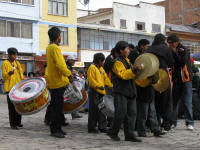
| Averages | USD | ||||
| Cost of diesel per litre | 0.67 | ||||
| Camping per night | South America menu | ||||
| Hotels per night | 14.05 | ||||
| Total | |||||
| Kilometers traveled | 1,584 | Home Page | |||
| Days in country | 16 |